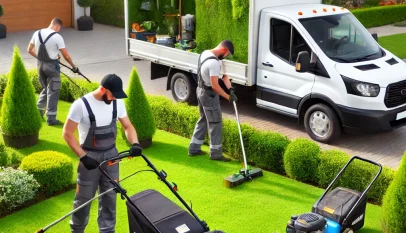Lawncare Services: Essential Tips for a Lush and Healthy Lawn
Lawncare services play a crucial role in maintaining the health and appearance of green spaces. Regular lawn maintenance not only enhances curb appeal but also contributes to the overall value of a property. Understanding how these services can benefit any landscape leads to more informed choices for homeowners and property managers alike.
Many individuals underestimate the impact that professional lawncare can have. It involves more than just mowing; services can include aeration, fertilization, and pest control, all tailored to the specific needs of the grass and soil. Each step helps create a vibrant outdoor area that can thrive year-round.
Choosing the right lawncare service can be overwhelming, given the variety of options available. It’s essential to research and find a provider that offers customized care plans based on local conditions and the unique requirements of each lawn. This approach ensures a manicured and healthy lawn that homeowners can enjoy.
Essential Lawn Care Services
Maintaining a healthy lawn requires a combination of services to ensure it remains vibrant and weed-free. Key services include mowing and trimming, fertilization, weed control, aeration, and irrigation management. Each service plays a vital role in promoting optimal growth and health.
Mowing and Trimming
Regular mowing is crucial for maintaining an even lawn height, which encourages growth and discourages weeds. Mowing should occur every 1-2 weeks, depending on grass type and weather.
Trimming edges around flower beds, sidewalks, and driveways enhances the lawn’s appearance. This should be done frequently to prevent overgrowth and maintain a neat, polished look.
Mower blades must be kept sharp to ensure clean cuts, promoting healthier grass. Varying the mowing pattern also helps prevent soil compaction and encourages stronger root systems.
Fertilization
Fertilization provides essential nutrients to the lawn, promoting vigorous growth and enhancing color. Using a soil test can determine nutrient deficiencies, guiding the choice of the right fertilizer blend.
Applying fertilizers should be done according to the season: spring for growth and fall for recovery. Proper timing maximizes the effectiveness of nutrients while minimizing waste.
Granular and liquid fertilizers offer different benefits. Granular fertilizers release nutrients slowly, while liquid fertilizers provide quick absorption for immediate results.
Weed Control
Weed control begins with prevention strategies, such as maintaining thick grass and healthy soil. A dense lawn competes with weeds for space and nutrients.
Applying pre-emergent herbicides in early spring can prevent weed seeds from germinating. Post-emergent herbicides target existing weeds and should be used carefully to avoid harming desirable plants.
Regular monitoring is vital for effective weed control. A combination of manual removal and chemical treatments can lead to a cleaner, healthier lawn.
Aeration
Aeration involves perforating the soil with holes to relieve compaction, allowing air, water, and nutrients to penetrate the root zone. This service is essential for lawns that experience heavy foot traffic.
Core aeration is the most effective method, where small plugs of soil are removed. This increases soil permeability and promotes deeper root growth.
Aeration should typically be performed during the growing season for optimal recovery. Following up with overseeding can enhance lawn density and health.
Irrigation Management
Effective irrigation management ensures adequate water supply while conserving resources. Understanding the lawn’s water needs based on grass type and climate is critical.
Implementing an irrigation schedule that accounts for rainfall and seasonal changes helps maintain moisture without overwatering. Grass generally needs 1-1.5 inches of water per week.
Smart irrigation technologies, such as drip systems and timers, enhance efficiency. These systems reduce water waste, promote healthier roots, and can save money in the long run.
Seasonal Lawn Maintenance
Seasonal lawn maintenance is crucial for maintaining a healthy and vibrant lawn throughout the year. Each season requires specific tasks to promote optimal growth and appearance.
Spring Lawn Preparation
Spring is a vital time for lawn care. As temperatures warm, grass begins to grow again. This season involves several key tasks:
- Soil Testing: Assess soil pH and nutrient levels. This helps in determining the necessary amendments.
- Aeration: Aerate the lawn to relieve soil compaction. This improves water and nutrient absorption.
- Fertilization: Apply a balanced fertilizer to kickstart growth. Use a slow-release formula for lasting effects.
- Weed Control: Pre-emergent herbicides can prevent weeds from taking root before they appear.
Proper spring preparation sets the foundation for a healthy lawn.
Summer Lawn Care
Summer requires attention to heat and water needs. High temperatures can stress grass, so maintaining its health is critical.
- Mowing: Keep grass at 2.5 to 3.5 inches to encourage deeper roots and shade the soil.
- Irrigation: Water early in the morning, providing about 1 inch of water weekly. This helps reduce evaporation.
- Fertilization: Fertilize with a nitrogen-rich product to promote lush growth. Aim for light applications to avoid burning.
- Pest Control: Monitor for signs of pests like grubs. Early intervention prevents significant damage.
Effective summer care helps sustain a vibrant lawn in challenging conditions.
Fall Lawn Services
Fall is a crucial transition period. Proper care in this season prepares the lawn for winter.
- Aeration: Aerate again to promote oxygen flow and nutrient uptake before winter.
- Fertilization: Apply a winterizer fertilizer high in potassium. This aids root development and resilience.
- Seeding: Consider overseeding to improve density. This helps fill in bare spots and thicken the lawn.
- Leaf Removal: Regularly remove fallen leaves. They can suffocate the grass if left unattended.
These fall services enhance the lawn’s durability against winter stressors.
Winter Lawn Protection
Winter protection is essential to safeguard the lawn from cold weather. While growth slows, care is still necessary.
- Mowing: Give the lawn a final mow before the first snow. This prevents matting under snow.
- Watering: Ensure the lawn is adequately hydrated before the ground freezes. Deep watering promotes stronger roots.
- Snow Management: Avoid piling snow from sidewalks and driveways onto the lawn. This can lead to mold and diseases.
- Soil Protection: Cover with a light mulch to insulate against extreme cold.
Taking these steps protects the lawn and ensures healthy re-emergence in spring.
British Virgin Islands Offshore Company Setup and Benefits Explained
The British Virgin Islands (BVI) is a leading offshore jurisdiction widely chosen for comp…














